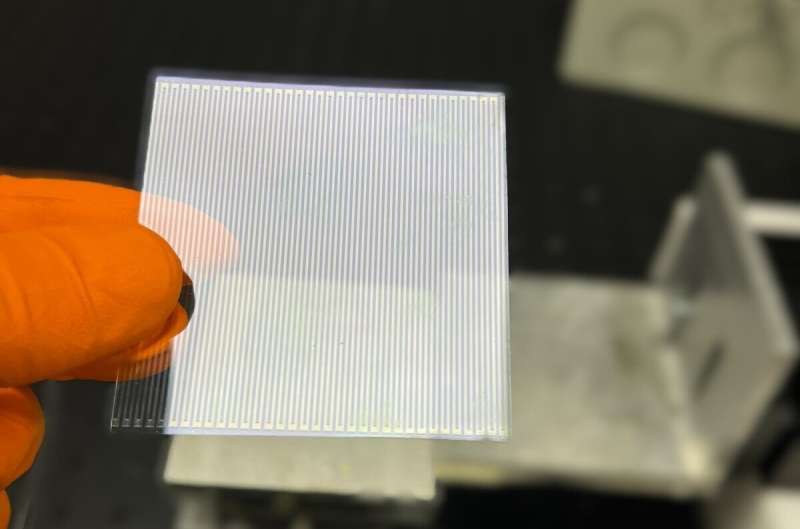This article has been reviewed according to Science X's editorial process and policies. Editors have highlighted the following attributes while ensuring the content's credibility:
fact-checked
peer-reviewed publication
trusted source
proofread
Flexible nanogenerator with enhanced power density could one day rival the power of solar panels

Your early morning run could soon help harvest enough electricity to power your wearable devices, thanks to a new nanotechnology developed at the University of Surrey.
Surrey's Advanced Technology Institute (ATI) has developed highly energy-efficient, flexible nanogenerators, which demonstrate a 140-fold increase in power density when compared to conventional nanogenerators. ATI researchers believe that this development could pave the way for nano-devices that are as efficient as today's solar cells.
The findings are published in the journal Nano Energy.
Surrey's devices can convert small amounts of everyday mechanical energy, like motion, into a significantly higher amount of electrical power, similar to how an amplifier boosts sound in an electronic system. For instance, if a traditional nanogenerator produces 10 milliwatts of power, this new technology could increase that output to over 1,000 milliwatts, making it suitable for energy harvesting in various everyday applications.
ATI's nanogenerator works like a relay team—instead of one electrode (the runner) passing energy (charge) by itself. Each runner collects a baton (charge), adds more and then passes all batons to the next runner, boosting the overall energy that is collected in a process called the charge regeneration effect.
Lead author of the study from the University of Surrey, Md Delowar Hussain, said, "The dream of nanogenerators is to capture and use energy from everyday movements, like your morning run, mechanical vibrations, ocean waves or opening a door.
"The key innovation with our nanogenerator is that we've fine-tuned the technology with 34 tiny energy collectors using a laser technique that can be scaled up for manufacture to increase energy efficiency further.
"What's really exciting is that our little device with high energy harvesting density could one day rival the power of solar panels and could be used to run anything from self-powered sensors to smart home systems that run without ever needing a battery change."
The device is a triboelectric nanogenerator (TENG)—a device that can capture and turn the energy from simple, everyday movements into electricity. They work by using materials that become electrically charged when they come into contact and then separate—similar to when you rub a balloon on your hair, and it sticks due to static electricity.
Dr. Bhaskar Dudem, co-author of the study from the University of Surrey, said, "We are soon going to launch a company focused on self-powered, non-invasive health care sensors using triboelectric technology. Innovations like these will enable us to drive new spin-out activities in sustainable health tech, improve sensitivity, and emphasize industrial scalability."
Professor Ravi Silva, co-author of the study and Director of the Advanced Technology Institute at the University of Surrey, said, "With the ever-increasing technology around us, it is predicted that we will have over 50 billion Internet of Things (IoT) devices in the next few years that will need energy to be powered.
"Local green energy solutions are needed, and this could be a convenient wireless technology that harnesses energy from any mechanical movements to power small devices. It offers an opportunity for the scientific and engineering community to find innovative and sustainable solutions to global challenges."
"We are incredibly excited about the potential of these nanogenerators to transform how we think about energy. You could also imagine these devices being used in IoT-based self-powered smart systems like autonomous wireless operations, security monitoring, and smart home systems, or even for supporting dementia patients, an area in which the University of Surrey has great expertise."
More information: Md Delowar Hussain et al, Exploring charge regeneration effect in interdigitated array electrodes-based TENGs for a more than 100-fold enhanced power density, Nano Energy (2024). DOI: 10.1016/j.nanoen.2024.110112

















